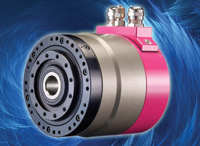
Posted to News on 23rd Apr 2015, 00:00
A deep dilemma
Delving into oil and gas extraction using precision gears: Steve Kirk of Harmonic Drive looks at the technological challenges and how high precision gearing is being increasingly used to drill deeper.

>Having exhausted reserves in many subsea oil fields, the pressure is now building on extraction companies to drill deeper and for longer, to obtain every last drop of the black gold. Existing equipment is not always rated for operation in the extreme temperatures, pressures and associated logistics of deep sea extraction. This is creating technological challenges all the way from the top to the bottom of the supply chain. From topside platforms to subsea structures and all the way further downhole to the directional drill bit, OEMs face the challenge of developing equipment that can withstand the harsh environment.
>Gearing based electrical actuation is more economical, ecological, controllable and more reliable than traditional hydraulic actuation systems, which can develop oil leaks over time. The need to frequently service hydraulic systems at depths of 6000m is neither economically feasible nor necessary with the advent of electromechanical systems. The high single stage ratio of Harmonic Drive gears results in a compact unit with a very high torque-to-volume and torque-to-weight relationship. When used downhole, the annular design of the gear allows optimal use of the available space with the addition of a hollow shaft.
>Starting topside, a single platform could be just one piece in a large extraction application spanning hundreds of miles. As these networks increasingly begin to operate further afield, adverse weather conditions, a lack of resources and signal issues can severely hamper communication between vessels.
>The positional antenna systems that enable radio communication between the platform, vessels and onshore teams often suffer from inaccuracy due to gearing with backlash characteristics. This problem can be solved using a Harmonic Drive servo actuator. Its unique construction offers a combination of fixed circular spline, flexible spline and elliptical wave generator bearing, high reduction ratios can be achieved in a single stage. This simultaneously eliminates backlash and increases accuracy, all in a servo motor driven compact unit complete with feedback sensor.
>As we leave the choppy surface of the sea and dive deeper, subsea applications vary from remotely operated vehicles (ROVs) all the way up to permanent subsea structures spread over many miles. ROVs are made to perform all types of underwater operation and maintenance. A typical task would be to open and close valves on an underwater valve manifold using a torque tool. These ROVs rely on the pan and tilt action to operate the camera system.
>As cameras begin to be increasingly used in conjunction with robotic arms and manipulators we are seeing a growing trend of replacing hydraulic actuators with electric actuators to take advantage of the increased accuracy and controllability.
>Another area of innovation that will be of great significance over the next few years is that of remotely operated permanent subsea structures. Also known as Christmas trees, these structures are currently attached in-line with the oil wellhead and are responsible, amongst other things, for controlling the flow, temperature and pressure of the well. If remote electromechanical actuation becomes used widely, these Christmas trees could be operator controlled over Ethernet.
>Whereas ROVs and antennas require accuracy, the challenge with valve actuation has always been reliability. Traditionally, hydraulic valve actuation has suffered from seal corrosion due to the prolonged exposure to high pressure and harsh saltwater. Subsequent leakage of the units has resulted in component failure, requiring them to be replaced at high cost. The low part count of a Harmonic Drive component set ultimately raises the mean time between failures (MTBF), resulting in a higher return on investment (ROI) over the product's lifetime.
>Finally, drilling through the seabed takes us downhole into the complex world of subsea oil fields. As the oil levels in shallow fields begin to diminish there is a drive to drill into deeper reserves. The problem is that the deeper oil is spread sporadically over vast distances, often in horizontal pockets. Using a continuous vertical wellbore is not feasible and so the concept of directional drilling was developed.
>Rotary steerable systems (RSS) 'point-the-bit' technology uses Harmonic Drive component sets to vary the angle of inclination of the drill bit. This flexibility allows operators to achieve complex 3D well designs, connecting multiple marginal targets for high volume, efficient recovery. The high reduction ratio and annular design of the component makes it ideal for this application, with the inherent accuracy of the gear allowing tight control of wellbore placement and geo-steering. Combined with azimuth, gamma ray and inclination measurements at only 1m from the drill bit, this ensures effective directional drilling and gives operators a better log of formation tendencies.
>It's often said that space is the final frontier, but having only explored around five percent of the ocean floor and about half a percent of the ocean itself, the ocean might be more truly deserving of that title. As fossil fuels continue to diminish and our reliance on them increases, it will become essential that new exploration technologies are able to cope with the scorching temperatures, the crushing pressures and the harsh environment of deep sea extraction.
Unit 36, Wolseley Court
Staffordshire Technology Park
ST18 0GA
UNITED KINGDOM
+44 (0)1785 245190








